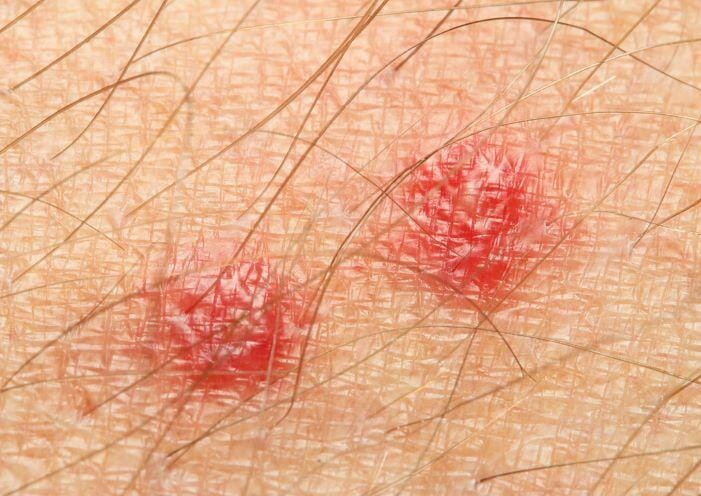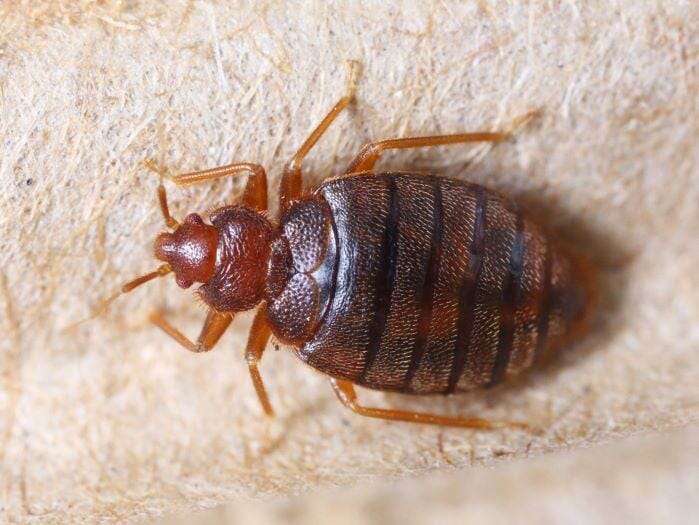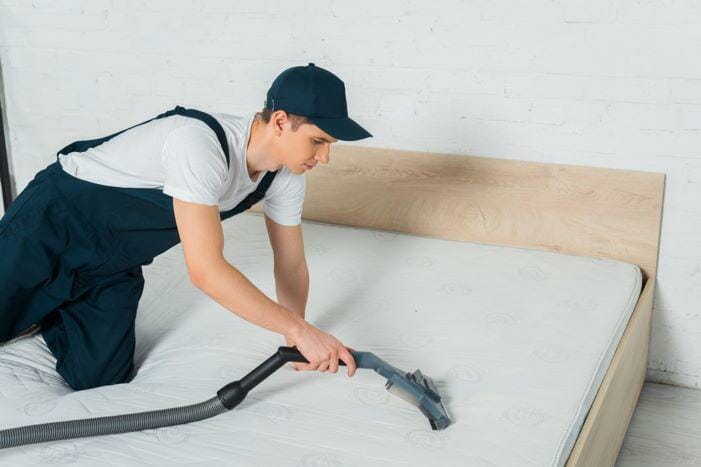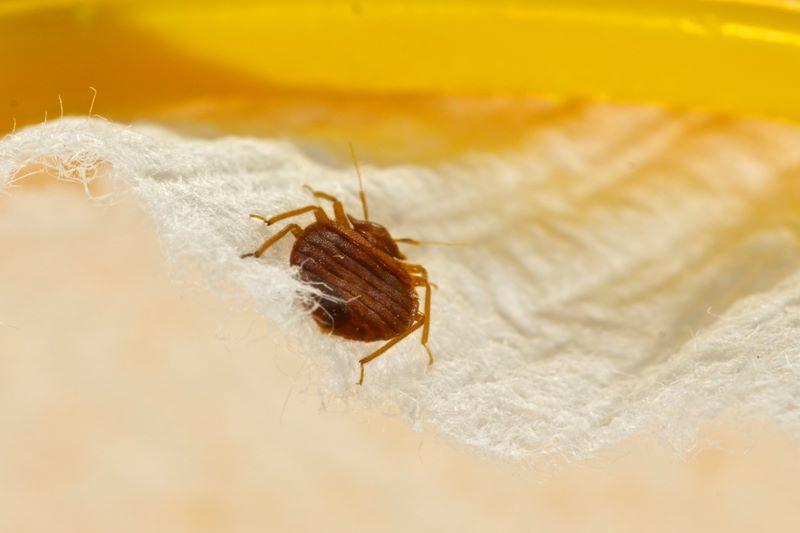When you lie down in bed each night, the last thing you want to think about is bed bugs.
For over 15 years, we’ve provided pest control services to customers in the San Francisco Bay Area and Central Coast.
In this post, we’ll share our top strategies for eliminating bed bugs on your own.
Key Takeaways
- To get rid of bed bugs, inspect your mattresses and furniture to identify harborage areas, contain the infestation, kill the bed bugs and eggs, monitor affected areas, and, if necessary, contact an exterminator for professional assistance.
- Signs of a bed bug problem include small pale yellow eggs and rust-colored droppings on bedsheets and pillowcases. There may be a pervasive locker-room smell in the affected area.
- DIY treatment options for eliminating bed bugs include heat, steam and chemical products. Repeated applications are often necessary. Pest control professionals usually handle the job with one visit.
Signs of an Infestation

Bed bugs are tiny–usually no larger than the point of a pen–so it can be hard to spot them at first. If you think you may have a bed bug infestation, keep an eye out for these signs:
- Evidence of the bugs themselves, such as shed skins or black droppings in mattress seams or other items.
- Bites, welts, or bumps on your body in the morning after you get out of bed.
While realizing you have bed bugs can be alarming, identifying them is the first step to treating them.
Before You Get Started
Take these steps before you begin your DIY bed bug treatment program:
1. Make sure you have the go-ahead for treatment
If you live in a rental, make sure your landlord is okay with you beginning DIY bedbug treatment.
If you intend to use pesticides, check your local laws and regulations to make sure you’re allowed to use those products in the affected area.
2. Make a plan
Next, come up with a plan to get rid of the bed bugs in your space.
We recommend choosing an appropriate treatment method – we’ve outlined them in this article – and then deciding where, when, and how you’ll deploy each one.
You should also have all needed tools, products, and equipment (including PPE such as gloves) ready before you start.
5 Steps to Get Rid of Bed Bugs

1. Find bed bug harborage areas
If you think you have a bed bug infestation, the only way to be sure is to locate and identify the bugs visually.
Use a flashlight and check each area carefully. Look for tiny dark or rust-colored droppings, live bedbugs, or small pale yellow eggs.
Follow the scent of any offensive musty odors in your room or around your bed, which some people say reminds them of “locker room smell.”
Here’s where to look for bedbugs and what signs you should keep an eye out for:
- Mattresses. Pay close attention to the areas around folds, seams, and buttons. Inspect the area between the mattress and box spring, as well as the meeting points between headboards and bed frames. Look for tiny blood stains on your sheets or pillowcases.
- Box springs. Check the area around and inside of your box springs, as well as the box springs’ batting, slats, and frame.
- Headboards. Inspect headboard cracks and crevices and the area where the headboard secures to the bed frame or wall.
- Nightstands. Look for signs of bedbugs in and around nightstands and other furniture near the bed. This includes appliances, such as clocks and phones, that may sit on the nightstand. If you have televisions, computers, or smoke detectors in your room, check the gaps and cracks inside of them for signs of bedbugs.
- Textiles. Check any quilts, blankets, bedspreads, and pillows that you keep on or near the bed.
- Walls. Next, search the walls near your bed. Look behind the face plates of your bedside outlets and electrical boxes, and check the tiny cracks and crevices behind wood paneling and trim and behind baseboards. Inspect the area between the carpeting and baseboard, and peek under the edges of the carpet, if possible.
- Furniture. Check for signs of bedbugs in the cracks and crevices around and inside of upholstered furniture, drapery pleats, seams, and other possible hiding areas. You should also check for pests in the joints of furniture like couches, accent chairs, and futons.
- Around windows and door frames. Inspect the tiny gaps between your window’s molding and wall surfaces, as well as the cracks in your windows, door frames, and sills. If you have corner protectors in your home, take them off and inspect the space inside of and beneath them.
- In closets and clutter. Finally, check for bedbugs in the clothing in your closet and in any cluttered areas, like clothing piles on the bedroom floor or boxes or piles of magazines, books, or paper.
2. Contain the bugs
Once you’ve identified an active bed bug infestation, you have to contain it so it doesn’t spread.
Here’s how:
- Mattress encasements. One quick and easy way to contain bed bugs is to use a mattress encasement to protect your mattress and box spring. When zipped all the way up, these covers trap bed bugs and make it impossible for them to sneak back out. While that may sound gross, the mattress encasement creates a bite-proof layer that cuts the bed bugs off from their food source (you), starves them, and keeps them from migrating to other parts of your home. In addition to containing and killing active bedbug infestations, mattress encasements also form a protective barrier around your mattress that prevents new infestations from flaring up.
- Bed bug traps. Bed bug traps are simple devices that catch, kill, and contain bed bugs. Some varieties, like glue traps, are disposable, ready-to-use traps that use a sticky glue board to trap and kill bed bugs that crawl across them.
- Vacuuming. Thoroughly vacuum your mattress, the insides of your dresser, the seams and joints of your furniture, your carpets, and any other place you’ve noticed signs of bed bug infestation. If your linens are still on your bed, vacuum those as well. When you’ve finished, empty the contents of your vacuum canister into a bucket of hot, soapy water to kill bedbugs.
- Wash your bedding. Once you’ve vacuumed your bedding, remove it from the bed and seal it in a plastic trash bag until you can wash it. When you wash it, set the wash water to the highest possible setting and dry the item on “high.” If the item can’t be washed, put it in the dryer on “high” for 30 minutes.
Any items that cannot be cleaned should be disposed of safely.
3. Kill the bed bugs
Now it’s time to actually get rid of the bed bugs.
Here’s how:
Method |
Description |
| Heat or cold |
|
| Steam |
|
| Desiccants |
|
| Botanical insecticide spray |
|
| Insecticides |
|
| Residual treatments |
|
| Bug bombs |
|
Bed bug infestations can take weeks or even months to wipe out.
To make sure your treatment is working, check the infested area once a week for a few months. One great way to do this is to use devices like bed bug interceptors. These plastic, dish-like structures help detect and monitor bed bug infestations.
These interceptors are designed to be placed under the leg of your bed or upholstered furniture, where they create a barrier between the floor and the bed.
As bed bugs try to climb up or down the leg of the furniture, they fall into the plastic dish and become trapped.
If you notice new signs of bedbug activity in your bed bug interceptors, treat the area again.
When to Call an Exterminator

Let’s face it: even with the best DIY approaches, bed bugs can be difficult to find and eliminate.
After all, they’re tiny and capable of hiding in dozens of places around the house – so eliminating infestations can feel next to impossible.
If your DIY efforts have failed, it’s best to hire a professional exterminator, like Smith’s Pest Management in San Jose, CA.
Our team will evaluate your bed bug infestation and make a plan to remove all bugs and restore the peace and tranquility of your home.
Here’s the process our team follows:
1. Inspect the property and develop a management plan
Every pest control job we conduct starts with an inspection and consultation. We first inspect the affected areas of your home and property to locate bed bugs and identify inspections.
Based on that inspection, our techs will develop a management plan to get rid of the bed bugs permanently. We’ll also discuss bed bug treatment costs with you so you can budget for removal.
2. Deploy treatment
Next, our pest control experts will get to work actually treating your bed bug infestation. We offer a selection of bed bug treatment options, including the following:
- Heat Treatment
Heat treatment is ideal for large infestations in homes or hotels. These treatments are non-toxic and safe for people and pets, and will get rid of the entire infestation in just one visit. During heat treatments, we raise the internal temperature of your home to a level that bed bugs cannot survive. This method penetrates walls as well, which means it’s excellent for killing bed bugs in a couch or other hard-to-reach places.
- Steam Treatment
Steam treatment is similar to heat treatment, but it works on a smaller scale. These treatments are a good fit for less extensive infestations, and for customers who want a non-toxic solution.
- Chemical Treatment
Chemical treatments are effective for minor infestations that are caught early, or for infestations that require spot treatment. These treatments often require one to two follow-up visits to eliminate all bed bugs.
- Preventative Options
We offer preventive products like mattress encasements, which will help you prevent bed bug infestations. When used in conjunction with other methods, preventative methods can help keep your houses bed bug-free.
Dispelling Myths
1. Bed bugs only infest dirty homes
Many people believe bed bugs love dirty conditions and that they’re attracted by filth. This is why many people believe that sleeping in a cheap hotel is a surefire way to get bed bugs.
As it turns out, though, that’s just a common misconception.
Bed bugs are not drawn to dirt or decay. In fact, they can live in any environment as long as they have access to the one thing they need to survive:
Blood.
Unlike mosquitoes and ticks, which are also blood-eating insects, bed bugs can’t fly or live on their hosts. Instead, they must hide near their food source and wait for a meal to become available to them.
As such, bed bugs are highly adaptable. They can live anywhere from the cushions of a sofa to the carpet of a library as long as they can access regular blood meals.
2. Bed bugs won’t infest foam mattresses

While foam is too dense for bedbugs to live in, they can still set up shop in the tiny cracks and crevices around your foam mattress, including bed frames and headboards.
With this in mind, having a foam mattress isn’t enough to protect you from bedbug infestations.
3. Bed bugs can only travel by hitching rides on fabric, furniture, or suitcases
Not true! In fact, bedbugs can (and often do) crawl down hallways or through electrical outlets in multi-family housing units.
While they can travel on clothing, as well, they’re definitely capable of moving on their own.
4. The only way to get rid of bed bug infestations is to throw away everything
Fortunately, this is not true. Usually, you can use heat or cold to kill bedbugs in textiles, clothing, and furniture.
Once you’ve gotten rid of all the bedbugs in your belongings, you can use them safely again.
That said, bed bugs can come back, and you may need follow-up treatments to keep them out of your home.
Prevention Tips
- At hotels, keep your suitcase on a suitcase stand rather than on the floor. Wash all your clothing when you return home and put them in a hot dryer.
- Inspect used furniture before you bring it inside: check all seams, joints, tufts, and under cushions.
- Purchase a plastic or hypoallergenic cover for your mattress, box springs, and furniture to prevent bedbugs from entering the textiles.
- Get rid of clutter that could help bed bugs hide in your home. Paper, magazines, clothes, and other items should be picked up off the floor and nightstands and dressers should be cleaned regularly.
- Vacuum your mattress and floors often. Wash all sheets, clothing, and textiles at least once a week in hot water.
- Use caulk to seal cracks around baseboards, electrical outlets, light sockets, and furniture, so bed bugs can’t hide in them.
- Check for bed bugs in hotels, hostels, and guest rooms you sleep in. Click here to learn how.
Turn to Smith’s for Expert Bed Bug Control
Nobody wants to live with bed bugs. Fortunately, you don’t have to!
Here at Smith’s Pest Management, we help residential and commercial properties (including single-family homes, commercial facilities, hotels, and more) in Northern California—from Marin to Monterey—get rid of bed bugs and keep them out for good.
Contact us today to request a free quote: (408) 471-6988
FAQ
What Are Bed Bugs?

Bed bugs (scientific name cimex lectularius) are small, flat, invasive insects who rely on the blood of sleeping people and animals as their only food source.
Wondering how to identify bed bugs?
These unattractive insects are red-brown in color, and are about 1mm-7mm in length. While they rely on blood to keep them alive, they can go several months between meals.
Since a healthy female bed bug can lay up to 500 eggs in her lifetime, you can wind up with a serious infestation in a matter of just weeks.
What Causes Bed Bugs?
- Purchasing used furniture and bringing it into the home. Bed bugs can enter your space via luggage, purses, backpacks, used couches, and more.
- Cross-contamination in a multi-unit environment. Bed bugs can travel between rooms in apartment complexes and hotels.
- Contamination from a hotel, resort, or hostel. Bed bugs may get into your clothing or luggage and come home with you.
- New people staying in your home. Guests may come to stay at your home, bringing bed bugs with them without knowing.
Can bed bugs survive extermination?
Adult bed bugs cannot survive professional extermination. Still, it’s important to note that extermination won’t always kill bed bug eggs.
Because of that, we recommend having regular bed bug inspections after the initial extermination treatment.
These inspections will identify newly hatched bed bugs and provide follow-up treatments, as needed, to eliminate them.
How much does it cost to professionally get rid of bed bugs?
Average bed bug extermination cost varies depending on the method used and the severity of the bedbug infestation.
Generally, customers can expect to pay between $300-$5,000 for a comprehensive bed bug extermination, with the average cost falling around $1,750.
Getting rid of bed bugs is more expensive than getting rid of other pests, like fleas, because bed bugs can live for long periods without food (up to 400 days) and are often difficult to exterminate.
Can you get rid of bed bugs with baking soda?
No. Currently, there is no evidence that baking soda is an effective way to kill bed bug infestations. While applying baking soda may dehydrate and kill a few individual bed bugs, it’s not a strong enough treatment to get rid of a bedbug infestation.
What should I do with my pets during bed bug treatment?
To keep your pets safe during bed bug treatment, keep them out of the affected area. If you’re spraying insecticides, pets should not re-enter the treated area until the product you’ve used has dried, and the area has been well-ventilated with fans and open windows.
Are there any laundry detergents made specifically for bed bugs?
Yes. There are natural bed bug laundry products and additives designed to kill bed bugs at all life phases. You don’t need to purchase a special laundry detergent to do this, though. In fact, just washing your clothes and textiles in hot water with standard laundry detergent and then drying them on high is enough to kill bed bugs.
Can I get rid of bed bugs in one day?
Theoretically, it is possible to get rid of bed bugs in one day if you hire a professional to conduct a whole-house heat treatment. This involves using steam to expose bed bug harborage areas to high temperatures, which kills adult bed bugs and their eggs.


